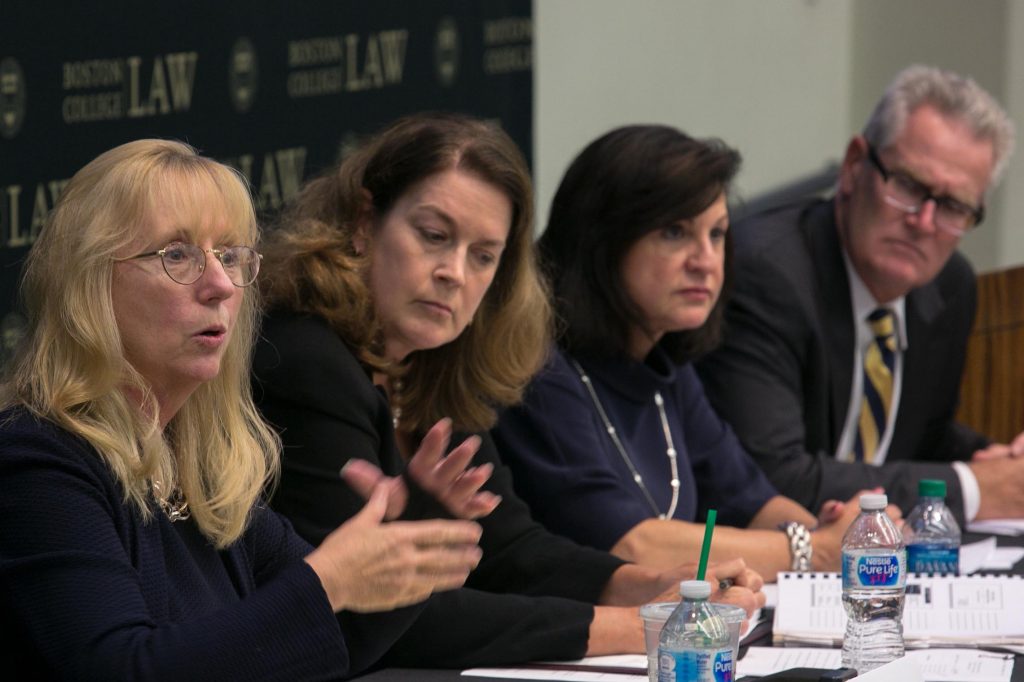What is a terrorist act? How does one respond to terrorism or a hate crime? Three past and present US Attorneys from the Districts of Massachusetts, South Carolina, and Central California provided in-depth accounts of responding to crisis situations, focusing on the Boston Marathon bombings, the San Bernardino, Calif., shootings, and the Charleston, SC, church massacre.
In defining crimes of terror and hate during a Rappaport Center for Law and Public Policy program at Boston College Law School on October 5, the three former and current top law enforcement officers, all women, explained that the fundamental framework of terror is a violent act aimed at influencing government or mass populations so as to impact policy and the people. Each panelist shared a detailed account of her response to the tragedies—touching on issues of jurisdiction, working with victims, prosecutorial decisions, the death penalty, community responses, and federal/state law enforcement collaborations.
First in the hierarchy of steps is public safety. The attorneys placed emphasis on “making sure there was no one else” involved in the crimes. After investigations revealed no immediate or additional threats, the attorneys proceeded with collecting evidence, searching for suspects if any remained, and trying to establish jurisdiction.
Panelist Carmen Ortiz, the former US Attorney for the District of Massachusetts and current Rappaport Distinguished Visiting Professor at BC Law, recalled holding a meeting in her office at the federal Moakley Courthouse the day of the Boston Marathon bombings. Ortiz said she received reports of explosions at the Marathon and raced to touch base with authorities to gather information and form a plan of action.
On Marathon Monday, April 15, 2013, Dzhokhar Tsarnaev and his brother Tamerlan Tsarnaev detonated homemade bombs near the finish line of the race. The bombs killed three people and injured nearly 300. Days later, while a manhunt was under way, the brothers killed an MIT police officer and, while attempting to escape, held an individual hostage. Upon discovering that the suspects were located in nearby Watertown, law enforcement swarmed the area and captured Dzhokhar Tsarnaev; Tamerlan Tsarnaev was killed.
Panelist Beth Drake, interim US Attorney for the District of South Carolina, was working the evening of June 17, 2015, when she received a call about an active shooter in Charleston, SC. Dylann Roof had walked into the Emanuel African Methodist Episcopal Church and opened fire on churchgoers, murdering nine people during closing prayers.
Panelist Eileen Decker, former US Attorney for the Central District of California, recalled that she was in her Los Angeles office on December 2, 2015, when a call came in reporting a mass shooting in San Bernardino, a few hours away. Syed Rizwan Farook and his wife, Tashfeen Malik, had gunned down guests at a holiday party at the Inland Regional Center, killing 14 and injuring many others. Farook and Malik were killed in a police shootout. Decker immediately drove to the area and ended up staying in San Bernardino for nearly three weeks.
In all three events, the panelists said, communication across multiple law enforcement agencies was critical. Jurisdiction had to be determined. Were these cases going to be prosecuted on the state or federal level?
Ortiz said that given the weapons of mass destruction used in the Boston Marathon bombings and information demonstrating possible ISIS radicalization, as well as a contextual note Dzohkar etched inside the boat in which he was hiding, federal jurisdiction was immediately acknowledged. However, since crimes had occurred in several counties, state jurisdiction remained in consideration. The Middlesex District Attorney’s Office ultimately decided to pursue prosecution of Tsarnaev for the murder of the MIT police officer; that prosecution has not yet occurred. After a lengthy and heart-wrenching trial in federal court, Tsarnaev was convicted and received the death penalty.
The panelists explained that the Department of Justice requires numerous approvals in order to classify a case as terrorism in the federal system. To seek the death penalty, the DOJ has promulgated a formal and multi-tiered protocol that ends with the Attorney General of the United States rendering the ultimate decision.
All three attorneys spoke with heavy hearts about the tragedies. Although the definition of terrorism remains debatable, the panelists’ commitment to achieving justice and public safety in the wake of such tragic crimes is not.
Photo, from left: Eileen Decker, Beth Drake, Carmen Ortiz, Professor Michael Cassidy


